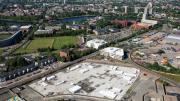In a September 19 letter to the Harvard and Allston communities released today, executive vice president Katherine N. Lapp announced the Harvard Corporation’s endorsement of the University's Allston Work Team recommendations (released last June), including plans to complete a 500,000- to 700,000-square-foot building for the sciences; to construct graduate student housing and a retail center; and to create an “enterprise research” park with a hotel and conference center. The letter outlined a two-part plan for pursuing the goals identified in that earlier report.
In the first phase, the University will build a health- and life-sciences center on the foundation previously constructed on Western Avenue in Allston. The academic planning for that facility, led by provost Alan M. Garber, will take place during the current academic year and will lead to a new proposed building plan no later than June 2012. The letter notes that “health, life and interdisciplinary sciences will be an important component of the University's upcoming capital campaign” (not yet publicly launched) in order to help fund the project.
At Barry's Corner, at the intersection of Western Avenue and North Harvard Street, development partners will plan, build and manage student rental residences and a retail center. Beginning in October, the University will host a series of public planning meetings with the Allston community, led by Elkus Manfredi architects, to solicit ideas and feedback from residents that could be incorporated into requests for proposals scheduled to go out by March to those third-party developers. The letter indicated that the timeline for major academic planning for Allston, which will involve use of a site now occupied by the Charlesview Apartments, would be determined once the new Charlesview Residences now under construction are occupied, but before demolition of the existing apartments begins.
In the second phase of its Allston plans, Harvard will identify development partners for the enterprise research campus, hotel, and conference center slated for a site known as Allston Landing North that lies further north and on the opposite side of Western Avenue near the Genzyme plant.
“Harvard anticipates that the planning efforts associated with these two phases will result in a new Institutional Master Plan Notification Form (IMPNF) submission by December 2012,” the letter stated, with the eventual goal, after consultations with the Boston Redevelopment Authority and the local community, of creating a new Institutional Master Plan for Harvard in Allston.








